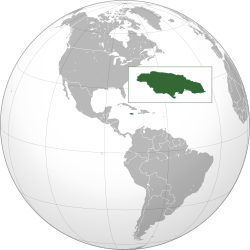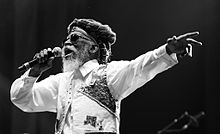Portal:Jamaica
The Jamaica Portal
Jamaica (/dʒəˈmeɪkə/ ⓘ jə-MAY-kə; Jamaican Patois: Jumieka [dʒʌˈmie̯ka]) is an island country in the Caribbean Sea and the West Indies. At 10,990 square kilometres (4,240 sq mi), it is the third largest island—after Cuba and Hispaniola—of the Greater Antilles and the Caribbean. Jamaica lies about 145 km (90 mi) south of Cuba, 191 km (119 mi) west of Hispaniola (the island containing Haiti and the Dominican Republic), and 215 km (134 mi) south-east of the Cayman Islands (a British Overseas Territory). With 2.8 million people,0 Jamaica is the third most populous Anglophone country in the Americas (after the United States and Canada), and the fourth most populous country in the Caribbean. Kingston is the country's capital and largest city. Most Jamaicans are of Sub-Saharan African ancestry, with significant European, East Asian (primarily Chinese), Indian, Lebanese, and mixed-race minorities. Because of a high rate of emigration for work since the 1960s, there is a large Jamaican diaspora, particularly in Canada, the United Kingdom, and the United States. The country has a global influence that belies its small size; it was the birthplace of the Rastafari religion, reggae music (and such associated genres as dub, ska and dancehall), and it is internationally prominent in sports, including cricket, sprinting, and athletics. Jamaica has sometimes been considered the world's least populous cultural superpower. (Full article...) Selected article -Port Royal is a town located at the end of the Palisadoes, at the mouth of Kingston Harbour, in southeastern Jamaica. Founded in 1494 by the Spanish, it was once the largest and most prosperous city in the Caribbean, functioning as the centre of shipping and commerce in the Caribbean Sea by the latter half of the 17th century. It was destroyed by an earthquake on 7 June 1692, which had an accompanying tsunami, leading to the establishment of Kingston, which is now the largest city in Jamaica. Severe hurricanes have regularly damaged the area. Another severe earthquake occurred in 1907. Port Royal became home port to English and Dutch government sponsored privateers who were encouraged to attack Spanish vessels, at a time when many European nations were reluctant to attack the powerful Spanish fleet directly. As a port city, it was notorious for its gaudy displays of wealth and loose morals, with the privateer crews spending their treasure in the many taverns, gambling houses and brothels which catered for the sailors. When the British and Dutch governments officially abandoned the practice of issuing letters of marque to privateers against the Spanish treasure fleets and possessions in South America in the later 16th century, many of the crews turned pirate to allow themselves to maintain their plundering illegally. Port Royal effectively became a pirate republic, and they continued to use the city as their main base during the 17th century. Pirates from around the world congregated at Port Royal, coming from waters as far away as Madagascar. The town became notorious in folklore as 'the wickedest city on Earth'. (Full article...)Did you know (auto-generated)
Selected biography -
Neville O'Riley Livingston OM OJ (10 April 1947 – 2 March 2021), known professionally as Bunny Wailer, was a Jamaican singer-songwriter and percussionist. He was an original member of reggae group The Wailers along with Bob Marley and Peter Tosh. A three-time Grammy Award winner, he is considered one of the longtime standard-bearers of reggae music. He was also known as Jah B, Bunny O'Riley, and Bunny Livingston. (Full article...)
General images -The following are images from various Jamaica-related articles on Wikipedia.
This is a Good article, an article that meets a core set of high editorial standards.
"Guava Jelly" is a song recorded by the Jamaican group Bob Marley and the Wailers. It was released as a 7" vinyl single through Tuff Gong and Green Door Records. It was issued commercially with B-side track "Redder Then Red", which was misspelled on its initial printing, in 1971. It was written and produced by Marley and features uncredited lyrical contributions from Bunny Livingston. A reggae composition like the majority of Marley's works, "Guava Jelly" contains a rocksteady and island-like production with lyrics loosely based around sexual intercourse. His use of the term "guava jelly" was likely referring to a specific type of sexual lubricant. It was favorably viewed by several reviewers, with many of them finding the composition to be sexual and about love. The group placed "Guava Jelly" on several compilation albums, including Africa Unite: The Singles Collection in 2005, and Owen Gray and Herbie Mann created their own versions in 1974 and 1975, respectively. American artists Johnny Nash and Barbra Streisand also recorded "Guava Jelly" and released their versions as commercial singles in 1972 and 1974, respectively. Nash's version was featured on his eleventh studio album, I Can See Clearly Now (1972), and was distributed in the 7" format in Jamaica and South Africa as the record's fourth and final single. Rita Marley, Bob's wife, was upset that Nash had recorded it since he might be credited for the single's success and not Marley. Streisand's rendition was included on her sixteenth studio album, ButterFly (1974), and released as the record's lead single on 16 December 1974. It divided music critics in the way that several thought her voice was not suited for reggae music. In 1991 the singer would appear on Larry King Live and admit her disappointment in ButterFly and the songs that appeared on it. (Full article...)Selected picture - Destruction of the Roehampton Estate, January 1832, by Adolphe Duperly
Selected cuisines, dishes and foods - Mannish water is a goat soup in Caribbean cuisine. It is believed to be an aphrodisiac and is made from various goat parts. The soup has been sold packaged since 2006 when it competed for Best New Food Idea in a competition covered by The Jamaica Observer. The Spicy Hill Farms company is behind the product, an offering of "Jamaica's favourite party soup". The meal has been part of Maroon celebrations for over 300 years. The pieces of goat are seasoned with local herbs and spices, and cooked along with vegetables and 'food' - yam, potato, bananas and dumplings." Feedback indicated it was going to be as popular as Tastee patties. The Observer reported that mannish water is still popular at 'dead yard' functions, large stage shows and parties (to make sure one can drive home after a few drinks). The food company's factory is in the hills bordering Manchester and Trelawny parishes. (Full article...)
More did you know
Selected listsTopicsCategoriesRelated portals
WikiProjectsGeographical:
History and Society:
Tasks
Associated WikimediaThe following Wikimedia Foundation sister projects provide more on this subject:
More portals | ||||||||||




















































